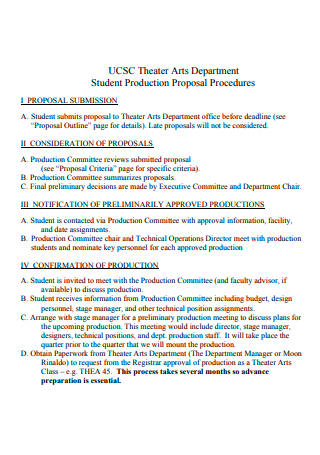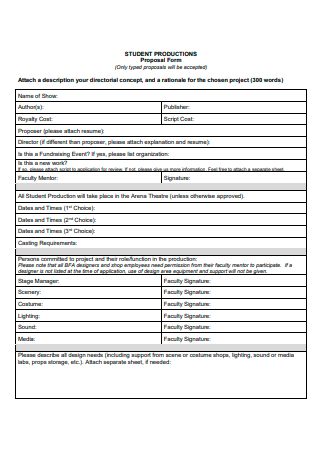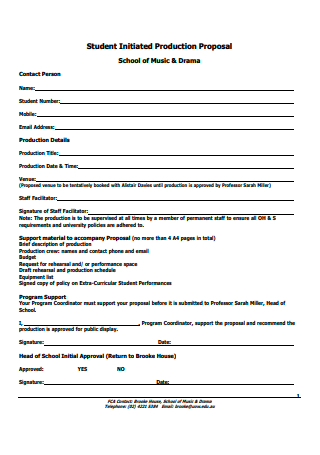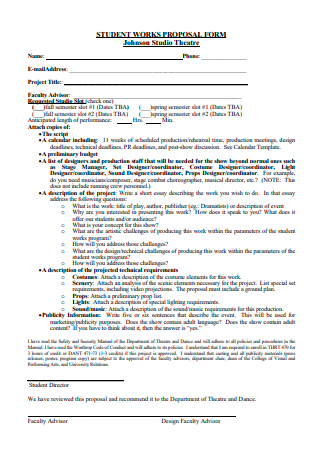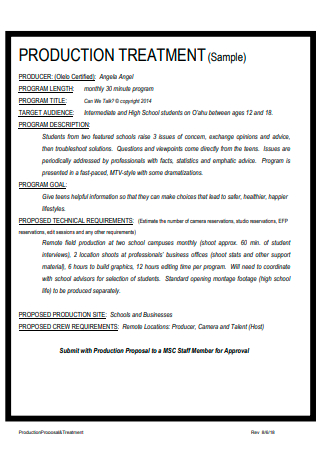4+ Sample Student Production Proposal
FREE Student Production Proposal s to Download
What Is a Student Production Proposal?
A production proposal is a brief document produced in a business manner with the aim of obtaining approval from the faculty and staff as well as potentially gaining funding for the students’ production. It follows the same style as a Book Proposal or a business plan, but it is customized particularly for the production industry.
As for a student production proposal, the intensity may be reduced as the clients are not in the official workforce. Although, keep in mind that an air of professionalism is still expected and multimedia projects by students should still hold the highest regard in communicating their ideas towards the faculty and staff, or whoever would be at the deciding end of the document.
Guidelines for Writing a Student Production Proposal
Cohen of Workamajig curates a list that can serve as essential to writing a student production proposal. The key things that any student project proposal should address are listed below. Proposal forms are provided for you within this article, you may check them for references.
Objective: Rather than providing a general conclusion, be as precise as feasible. Make sure to cite the main points and purpose of your student production proposal. Dissect the outcome you and the teacher agreed on following your first discussion.Scope: The project’s inclusiveness should have been explicitly specified. Don’t make the mistake of being ambiguous about your objectives. Instead, make a list of all of the jobs that are included and anticipated, as well as how you plan to do each one.Time Tracking: To complete the production in time, you will need to create a realistic timeline. Make a workable schedule for completing all of the tasks necessary to get your desired result, then give ample room for enhancements and changes. If problems emerge, you and the teachers can return to the timetable to check if you and the teachers are on the same page as planned or if changes need to be made.Budgeting: This is where your talent fee, costume, make-up and props, music and technical fees, and other tools will help you with the estimated budget. Make sure your pricing method is reasonable and consistent so as not to encounter challenges in terms of financial concerns in the production phase of your project. You can check out Student Budget Worksheets for a template to organize your budget.Revisions and Approval: Receive advice at key points throughout the schedule to see whether you need to change anything or whether everything is ready for production proper. So that there are no misunderstandings later on, have the teachers review you on each completed and authorized work. Within reason, you can allow for a limited number of changes, and anything that exceeds the permitted quantity may be dangerous if the production date is nearing.Maintain Manageable Timesheets: With so much going on, artists and creatives may overlook certain details. This is why having a document to refer to is important so you can always know where you stand with the project. In relation to keeping track of time, you, along with the rest of the members of the production, and the teacher or faculty can decide how much time to give every task after having broken down the production into a reasonable and realistic timetable, with some flexibility for modifications as needed. Be Sure to Include A Revision Period: Time, effort, and money are wasted on unexpected revisions. It cannot be avoided that minds change and ideas are shifted. You may encounter a situation where the rest of your crew and the teacher have agreed on something only for it to be altered at the last minute, thus, make sure to insert a period for revisions before the final production.
How to Write a Student Production Proposal?
Coming next is the step-by-step guide on how you can write your own student production proposal. Don’t let it overwhelm you as this is what the article is for, to guide you with ease and without any excess worries.
Step 1: Introduce yourself and explain your background.
The purpose of the opening of your proposal is to pique the reader’s attention. To make it obvious what the audience will be receiving, this paragraph should include basic information about your firm as well as an outline of the issue. If you’re following up on a meeting, mention it briefly in the opening lines to set the scene.
Step 2: Describe the proposal’s goal.
The common goal of your proposal is to describe what you want to achieve or what problem you want to solve. A student proposal for production would include specific information and fundamental ideas regarding what the play aims to accomplish or be about. You can elaborate if your production is for a charity, a cause, or what its intentions are.
Step 3: Establish your objectives and goals.
Describe the long-term goals you want to achieve, as well as the goals you’ll set to get there. If possible, give precise statistics and be as explicit as possible. You may think this is redundant to the earlier step, but this particular part caters to you as the individual who is writing the proposal. Which would be as specific as your own ideas can get.
Step 4: Discuss the budget and how the funds will be spent briefly.
For decision-makers, the cost is a key consideration. Depending on why you’re writing a proposal letter, you may need to include information on how you’ll spend your money and where it’ll go. You won’t need to provide a detailed cost breakdown, but giving the instructor a rough sense of the budget can help the teacher gain a better understanding of the production.
Step 5: Finish with a request for follow-up and a call to action.
A call to action is a request for your receiver to take further action and generates a sense of urgency for them to do so. This may enhance the likelihood of their responding. This step might be as simple as responding to your proposal to see if they want to talk more. In addition, stating that you want to follow up with them shows that you are serious about your idea. Let them know when you are both available, so they know when to anticipate it.
Create a document for your project proposal after you have defined and fleshed it out, and send copies to yourself, the rest of the crew and team members of the production, and of course your teacher or authority figure supervising the production, with both of your signatures and contact information.
The Different Roles of a Production Team
A team does not solely comprise of just one member doing all the work, and in order for a production to run smoothly, each individual must have a task assigned to them. These responsibilities carried out by each individual strengthens the team to perform a commendable production. All of the responsibilities described below can be shared by numerous students, resulting in a more well-rounded learning experience. Government Technology expounds on the list of roles.
Producer: Often referred to as the group leader, they are in charge of overseeing the entire production from beginning to end. The producer takes the project from conception to completion, ensuring that the script is completed, securing funding, and overseeing the different production staff. The producer also oversees the production process to ensure that everyone involved stays on track and stays under budget. Multimedia or any kind of production do not get created without a producer at the forefront.Director: The director is mostly in charge of directing the production and assembly. While the director may be compared to the author of a novel as the primary visionary for production, they would not be able to produce the picture without the assistance of a large number of other artists and technicians. Although the main difference as an author is that the author does everything, from plotting out the flow of the story to doing the revisions and editing of the structure, whereas the director may work at the center of the production, but has aid from other members of the production.Screenwriter: While a production’s language may appear natural to the audience, it was meticulously crafted by a screenwriter; nevertheless, the screenwriter does considerably more than supply conversation for the performers. They also structure the order of events in production to ensure that one scene flows smoothly into the next, allowing the plot to unfold in a logical and engaging manner. The screenwriter’s job, like that of the producer, is often disregarded by the general public, despite the fact that it is critical to the success of any production. There will be no production if there is no script.Production Designer: The production designer is the first artist to transform the screenplay into visual form before one inch of the production is shot if it’s a film or presented to a live audience if it’s a stage play. They produce a set of storyboards that act as the initial draft of the film. A storyboard is a set of sketches on panels that depicts the story’s visual development from one scene to the next. The visual consistency of the production is also ensured by creating this sketch of the film on storyboards. Storyboards serve as a visual reference for the director during the production and as a template for the editing process.Art Director: The art director is in charge of the production’s surroundings, which include the buildings, landscapes, and interiors that give the characters physical context. This individual is in charge of obtaining items, decorating sets, and ensuring that the environment looks realistic.Costume Designer: The characters’ economic position, employment, and attitude toward themselves are all conveyed through their costumes, which reveal a lot about the film’s historical period and the individuals that wear them. Consider how clothing may visually reveal something about the character.Cinematographer: If your production will be shot as a film, this role will play a role in it. The director of photography, or DP, is in charge of filming or videotaping the script. The DP must be aware of the camera’s technical capabilities as well as the illumination. When the director wants a scene to have particular visual or atmospheric elements, the DP uses lighting, film material, and precise camera manipulation to create such attributes.Editor: This role only applies if you are creating a film, the editor begins organizing the material and arranging separate shots into one continuous sequence shortly after shooting begins. Even in a single scene, dozens of different images from hundreds of feet of the film must be picked and combined. The editor’s decisions regarding which shots to use and in what sequence to utilize them have a significant impact on the finished film’s aesthetic. See Video Production Proposal for another sample relating to the production proposal format.Actors: Actors collaborate closely with the director and cinematographer to represent the characters in a production. When you consider an actor’s function in this wider context, it becomes clear that their work is far more challenging than simply showing up on set and reciting lines. As they are the central focus all throughout the production, their movement and delivery are also important and have pressure attached to the quality of their performance. If you are opting for a more heavily dramatic performance, check out Theatre Proposals for another format.Music Supervisor: Since the early days of cinema in the 1890s, music has been an important element of the experience. Even the most basic silent pictures were accompanied by a pianist or organist. The audience will be more engaged in the plot if the proper music is chosen for the picture. If you think music is not necessary for a production, then you have to reconsider the additional emotional effect it does to the entire production and towards the audience or viewers. If you would need to contact an official band, you may draft out a Musician Contract for musical accompaniment.
FAQs
A student is expected to be polite, no matter who it is you are addressing any document to. Make sure to thank the teachers and faculty for taking the time to evaluate your production proposal and urge them to contact you with any questions. Finish the letter with a formal conclusion. Also, add in your name a few lines below, and don’t forget to verify the document with your signature.
If you are planning to enter the field of video production or theatre production, Provideo Coalition recommends assuming that creating a formal proposal exudes professionalism. Not only that, but it helps to provide additional background and proof of your experience working in such a field. However, writing takes time, so make sure your thoughts are in line with the direction provided to you to avoid errors and unnecessary changes.
What is the purpose of a student production proposal?
The main purpose of a student production proposal is to ensure a smooth student presentation which would not be possible without the presence of a successful proposal. Through a student production proposal, details regarding the production held by students are organized and minimize the chances of certain details being left out.
A well-written production proposal may demonstrate to the faculty and staff that you completely comprehend their requirements and that you are the most qualified student for the job. It’s a fantastic organizing tool that allows you to highlight your production plan and intentions, what you bring to the table, and what makes you uniquely suited to work on and bring to life the contents of your student production proposal.

